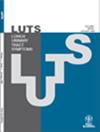Neurogenic lower urinary tract dysfunction in association with severity of degenerative spinal diseases: Short-term outcomes of decompression surgery
Abstract
Objectives
Cervical myelopathy (CM) and lumbar canal stenosis (LCS) are common degenerative spinal diseases among the elderly, and the major associated complaints include lower urinary tract symptoms (LUTS). The aim of this study was to investigate subjective and objective urological parameters of patients undergoing decompression surgery for CM and LCS.
Methods
We retrospectively reviewed patients who underwent evaluation by the International Prostate Symptom Score (IPSS) and uroflowmetry before decompression surgery for CM and LCS. Patients with comorbidities that can affect LUTS were excluded. Postoperative changes were evaluated in patients followed up within 1 month.
Results
Among referrals to urological consultations for LUTS, 231 patients were evaluated preoperatively. Moderate-severe urinary symptoms (IPSS ≥ 8) were present in 59.8% of 92 CM patients and 64.0% of 139 LCS patients. Poor voiding patterns defined as maximum urinary flow rate <12 mL/s or postvoid residual volume >100 mL were identified in 26.1% of CM and 25.2% of LCS. While IPSS did not associate with disease severity, poor voiders presented with worse Japanese Orthopedic Association scores. Moreover, poor voiders suffered for a longer period of time from orthopedic symptoms due to LCS. In followed-up patients (CM, n = 32; LCS, n = 47), total IPSS, storage subscores, and voiding subscores were significantly improved after surgery, as was voiding time from uroflowmetry.
Conclusions
This study demonstrated high prevalence of lower urinary tract dysfunction of CM and LCS as well as short-term effectiveness of decompression surgery. These results would encourage urologists to consider an orthopedic consultation when lower urinary tract dysfunction is identified in patients with degenerative spinal diseases.

 求助内容:
求助内容: 应助结果提醒方式:
应助结果提醒方式:


